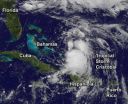(Press-News.org) The third tropical storm of the Atlantic hurricane season formed near the southeastern Bahamas on Sunday, August 24. NASA's Aqua satellite and NOAA's GOES-East satellites provided imagery of the storm's birth and movement.
System 96L lingered in the eastern Caribbean over the last couple of days and on Saturday, August 23, became a tropical depression. That depression strengthened into a tropical storm during the morning of August 24. A GOES-East satellite image was taken at 9:30 a.m. EDT on August 24 showed Cristobal as a rounded area of clouds north of Hispaniola (Haiti and the Dominican Republic) moving into the southeastern Bahamas. The GOES image was created at NASA's GOES Project office in NASA's Goddard Space Flight Center in Greenbelt, Maryland.
Upon its birth Cristobal had sparked Tropical Storm Warnings for Southeastern Bahamas, Including the Acklins, Crooked Island, Long Cay, the Inaguas, Mayaguana, the Ragged Islands, as well as the Turks and Caicos Islands, Central Bahamas, Including Cat Island, The Exumas, Long Island, Rum Cay, and San Salvador.
At 8 a.m. EDT on August 24, Cristobal's maximum sustained winds were near 45 mph (75 kph). The center of Tropical Storm Cristobal was located near latitude 23.0 north and longitude 73.0 west. That put the center just 40 miles (60 km) north of Mayaguana Island. A day later, Monday, August 24, Cristobal was still dropping heavy rainfall over the Turks and Caicos Islands as it moved slowly and erratically to the north-northeast.
Heavy rainfall is a problem for the islands because Cristobal is moving so slowly. The National Hurricane Center noted that the tropical storm is expected to produce rainfall totals of 4 to 8 inches over the Turks and Caicos as well as portions of the southeastern and central Bahamas through Tuesday, with isolated amounts around 12 inches possible. Minor flooding was already reported during the morning of August 25 near Pirates Cove on Mayaguana Island.
On August 24 at 15:55 UTC (11:55 a.m. EDT) Cristobal's center appeared near Turks and Caicos Islands in this visible image from the Moderate Imaging Resolution Spectroradiometer (MODIS) instrument aboard NASA's Terra satellite. In the MODIS image, it appeared that northerly wind shear was affecting the storm, blowing most of the strongest clouds and thunderstorms south of the center.
By August 25, the wind shear had not let up. The National Hurricane Center described the storm as remaining sheared with the low-level center fully exposed on the north side of the "deep convective cloud mass (the area of the strongest thunderstorms)."
At 11 a.m. EDT (1500 UTC) Cristobal was centered about 120 miles (195 km) east-northeast of San Salvador Island, Bahamas, and 715 miles (1,150 km) southwest of Bermuda. That puts the center of Tropical Storm Cristobel near latitude 24.6 north and longitude 72.7 west. Cristobal's maximum sustained winds were near 60 mph (95 kph) and some strengthening is expected over the next two days. Cristobal is moving toward the north-northeast near 2 mph (4 kph) and is expected to turn northeast and speed up on Tuesday.
The government of Bahamas has discontinued the tropical storm warning for the central Bahamas.
The National Hurricane Center noted that a strong, elongated area of low pressure (a trough) just of the U.S. east coast is forecast to capture Cristobal and gradually lift out the cyclone to the northeast.
INFORMATION:
Satellites capture the birth and movement of Tropical Storm Cristobal
2014-08-25
ELSE PRESS RELEASES FROM THIS DATE:
Can auriculotherapy help relieve chronic constipation?
2014-08-25
New Rochelle, NY, August 25, 2014— Nearly 1 in 6 adults worldwide may suffer from chronic constipation and, over time, the disorder can cause serious complications. Auriculotherapy, a form of acupuncture that involves stimulating targeted points on the outer ear, may help in managing constipation. Evidence from numerous clinical studies published between 2007-2013 that evaluated the effectiveness of auriculotherapy in treating patients with constipation is presented and discussed in a Review article in The Journal of Alternative and Complementary Medicine, a peer-reviewed ...
INFORMS study shows social welfare may fall in a more ethical market
2014-08-25
For "credence services" such as auto-repair, healthcare, and legal services, the benefit to the customers for the service is difficult to assess before and even after the service. A new study in a journal of the Institute for Operations Research and the Management Sciences (INFORMS) finds that in a credence services market, when more service providers care about the customer's well-being, society as whole may actually be worse off.
The study titled, "Signaling through Pricing by Service Providers with Social Preferences," is by Baojun Jiang (Washington University in ...
Anticipating experience-based purchases more enjoyable than material ones
2014-08-25
To get the most enjoyment out of our dollar, science tells us to focus our discretionary spending on trips over TVs, on concerts over clothing, since experiences tend to bring more enduring pleasure than do material goods. New research shows that the enjoyment we derive from experiential purchases may begin before we even buy.
The findings are published in Psychological Science, a journal of the Association for Psychological Science.
This research offers important information for individual consumers those who are trying to "decide on the right mix of material and experiential ...
Biomimetic photodetector 'sees' in color
2014-08-25
Rice University researchers have created a CMOS-compatible, biomimetic color photodetector that directly responds to red, green and blue light in much the same way the human eye does.
The new device was created by researchers at Rice's Laboratory for Nanophotonics (LANP) and is described online in a new study in the journal Advanced Materials. It uses an aluminum grating that can be added to silicon photodetectors with the silicon microchip industry's mainstay technology, "complementary metal-oxide semiconductor," or CMOS.
Conventional photodetectors convert light into ...
Do closed-loop insulin delivery systems improve blood glucose control in type 1 diabetes?
2014-08-25
New Rochelle, NY, August 25, 2014—In a closed-loop control approach to managing type 1 diabetes, glucose sensors placed under the skin continuously monitor blood sugar levels, triggering the release of insulin from an implantable insulin pump as needed. The aim of this closed-loop insulin delivery system is improved control of blood glucose levels throughout the day and night. But a new study in adults and adolescents found that mean blood glucose levels remained at safe levels 53-82% of the time, according to the results published in Diabetes Technology & Therapeutics ...
Study shows promise in automated reasoning, hypothesis generation over complete medical literature
2014-08-25
HOUSTON – (Aug. 25, 2014) – With approximately 50 million scientific papers available in public databases– and a new one publishing nearly every 30 seconds – scientists cannot know about every relevant study when they are deciding where to take their research next.
A new tool in development by computational biologists at Baylor College of Medicine and analytics experts at IBM research and tested as a "proof-of-principle" may one day help researchers mine all public medical literature and formulate hypotheses that promise the greatest reward when pursuing new scientific ...
EARTH Magazine: Changing the landscape: Geoscientists embrace 3-D printing
2014-08-25
Alexandria, Va. — The rapid proliferation of 3-D printing technology in the early 2000s sent ripples of excitement through the tech world and beyond, but the high price of printers put them out of reach for most academic researchers and hobbyists. Now, more affordable printers have broken this barrier, and geoscientists have started testing the waters.
From the delicate geometry of a crystal lattice to the sweeping strata of an anticline, geology is an inherently 3-D discipline. Three-dimensional printing offers the chance to make those structures replicable, communicable ...
Acrylamide exposure impairs blood-cerebrospinal fluid barrier function
2014-08-25
The blood-brain barrier prevents xenobiotics from entering the central nervous system. Growing evidence indicates that neurotoxins, such as tributyltin, manganese and nanoparticles, may disrupt the function of the blood-brain and blood-cerebrospinal fluid (CSF) barriers. Previous studies show that chronic acrylamide exposure leads to central and peripheral neuropathy. However, very few studies have focused on the effects of acrylamide exposure on these barriers. Prof. Yanshu Zhang and co-workers from Hebei United University in China found that acrylamide exposure damages ...
Deploying exosomes to win a battle of the sexes
2014-08-25
There are many biological tools that help animals ensure reproductive success. A new study in The Journal of Cell Biology provides further detail into how one such mechanism enables male fruit flies to improve their odds by stopping females from mating with other flies.
In addition to sperm, semen carries products that foster sperm survival, promote egg fertilization, and serve other functions that optimize a male's chances of passing along his genes. In male fruit flies, for example, reproductive accessory glands (thought to be equivalent to the prostate gland in humans) ...
Changes in the eye can predict changes in the brain
2014-08-25
Researchers at the Gladstone Institutes and University of California, San Francisco have shown that a loss of cells in the retina is one of the earliest signs of frontotemporal dementia (FTD) in people with a genetic risk for the disorder—even before any changes appear in their behavior.
Published today in the Journal of Experimental Medicine, the researchers, led by Gladstone investigator Li Gan, PhD and UCSF associate professor of neurology Ari Green, MD, studied a group of individuals who had a certain genetic mutation that is known to result in FTD. They discovered ...






